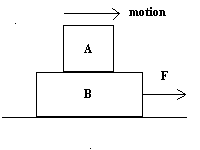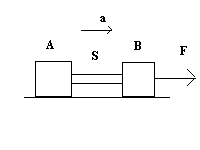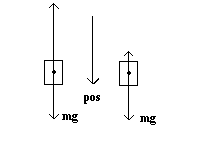| QUIZ 5 (ANSWERS) |
| CH. 4--EXERCISES./PROBLEMS 4, 10, 11, 14, 22, 23, 28, 29, 31, 32, 37, 38, 44, 46, 54 |
| READ ALL BOOK EXAMPLES SINCE SOME ARE LIKE DISCUSSIONS TO QUIZ PROBLEMS BELOW ! FOR EXAMPLES OF FORCE DIAGRAMS SEE SECTION 4.6 AND OTHER SECTIONS AS NEEDED. |
ICQ3-14-11 FIND acceleration x-component a, FSA and FSB in terms of the applied force magnitude F and the masses of box A, box B and string S. NOTE FSA and FSB are the magnitudes of the force on string S due to box A and box B, respectively .
|
| 4. See quiz 1. |
| 10. Done in class; we stated the graph of Vx vs t graph would look like the first 6.0 seconds of figure 4.34 qualitatively. |
| 11. See #10: Note the graph of this problem looks like the first 10 seconds of figure 4.34 qualitatively, except in this particular exercise the force would resume at 5.0 seconds instead of 6.0 s. For the first 2.0 seconds, get the acceleration from Newton's Second Law. |
| 14. See class notes and previous discussions. |
| 22. See conceptual example 4.9 and class notes. This is a nice exercise on the theme of Newton's Third Law. Fill in the blanks. For example in the first blank would be "the Earth." The three elements are your hand, Earth and the book in close analogy to conceptual ex. 4.9 |
| 23. There are three elements here: the
bottle, the air and Earth. Assume the bottle falls
straight down, (a) Review figure 4.1 (d) . While the bottle is falling, with the presence of air resistance, there are TWO FORCES. One of the forces you're already familiar with. The other is like a friction force acting in a direction opposite the bottle velocity. See figures 5.24 and 5,26, Chapter 5. (b) There are three "objects"--- Earth, air and bottle---and therefore there are three action reaction pairs. Let look at one of the pairs: Earth and bottle. We already know the action force is the downward pointing weight of bottle = vector-FBE = force on bottle due to Earth. Thus the reaction force is vector-FEB = force on Earth due to bottle. Note: vector-FBE = - vector-FEB . It's up to you to find the action-reaction pair for the following object pair: Air and bottle. (As far as the Earth - Air pair goes, we know the force on the air due to the Earth is equal and opposite to the force on the Earth due to the air, but this is not needed in the problem. |
28,  Let's examine the two cases below. But before you begin make sure you also isolate Block B and write down the equation of motion for BOTH blocks. In the following, the symbol "a" represents the x-component of acceleration. We assume the surfaces of contact between the blocks do not move relative to each other (i.e no slipping between Box A and B) Thus, the only possible force acting on Block A horizontally is the force of static friction causing A to accelerate to the right. That static friction is a contact force between Block A and B. On A, it acts on the bottom and is rightward. On B, it acts on the top and is leftward. (a) BLOCK A : The net force in the x direction is : FXNET = pos - neg. mA*a = fs - 0. Again, fs is the magnitude of the rightward static friction force pulling Block A to the right. The net force in the y direction is : FYNET = pos - neg. Since the motion is purely horizontal, 0 = pos - neg = NA - mA*g, Thus NA = mA*g. Note: NA is the upward normal force magnitude due to Block B below. BLOCK B : The net force in the x direction is : FXNET = pos - neg. mB*a = F - fs . F is the applied pulling force magnitude and fs is the magnitude of the static friction force (from contact with A) on Block B (due to Block A on top.) The static friction force on B is a reaction force to the static friction force on A due to B. The net force in the y direction is : FYNET = pos - neg. Since the motion is purely horizontal, 0 = pos - neg = NB - mB*g - NA, where NB is the normal force of the ground on Block B and NA is the downward normal force magnitude on B due to block A, a reaction force to the normal force of B on A. Thus NB = mB*g + NA = mB*g + mA*g as you might expect. Thus the two horizontal equations are : mA*a = fs and mB*a = F - fs . Note when you add the two equations the static friction force cancels out and you get (mA* + mB)*a = F . Please isolate each block and draw each force on the block in both the vertical and horizontal directions. (b) When there is friction between Block B on the bottom and the ground: BLOCK A : |
| 29. This is a classic problem modeling an accelerometer. Visit http://scienceblogs.com/dotphysics/2009/07/accelerometer2.php and scroll down to the equation for the ball attached to the string. When the ball hangs vertically straight down, the acceleration is zero; when the string makes an angle with the vertical in a direction opposite the forward motion, the acceleration is not zero. |
| 31. See the summary page 129 --see (4.7) and
(4.8) diagrams and examples 4.4 and 4.5 in the the body of
chapter. This time note the applied force is not
horizontal. Isolate the chair, represented as a block.
Assume she moves rightward, the positive direction. BLOCK : The net force in the x direction is : FXNET = pos - neg. mA*a = F*cos 37 - fk , where fk is the magnitude of the leftward kinetic friction force acting on the block. The net force in the y direction is : FYNET = pos - neg. Since the motion is purely horizontal, 0 = pos - neg = N - F*sin37 - mg. (a) Please isolate block and draw each force component on the block in both the vertical and horizontal directions. Remember to resolve the forces into components along each axis. (b) Solve for the normal force magnitude N. |
| 32. See lectures notes from 3-14-11.
Let up the incline be the +x direction. Thus along x: m*a = T - mgisin26. See example 5.4. Since the speed is constant, a = 0. |
| 37. (a) The net force in the y - direction must be zero in order to sustain the purely horizontal motion (x directed) . Thus: Fy + F1 *sin 60 - F2*sin30, on pure geometric grounds, where Fy is the y-component of the child's force. One would think the minimum force for the child requires the child's x-component of force Fx = 0. Solve for Fy. (b) FXNET = pos - neg. m*a = F1*cos60 + F2*cos30. |
| 38. For the force diagram see example 4.5 Find the magnitude of the acceleration from the 2ND LAW. Then use Ch. 2 methods to find the distance traveled before stopping . If the distance is greater than 500 m, find the speed of the boat at that distance. |
| 43. DONE IN CLASS;. |
| 44. (a) WHAT DOES NEWTON'S 3RD LAW PREDICT? (b) See class notes. (c) Use the 2ND LAW on astronaut, where FXNET = m*a = pos - neg. Let the pos direction be toward the spacecraft. Note the only force acting on the astronaut is the reaction force derived from part (a). Thus neg = 0 in the previous equation. (d) Same magnitude of force as on astronaut. Explain; see class notes. (e) Much smaller acceleration because the spacecraft has a huge relative mass--use 2ND LAW. |
| 46. Let down be the positive y direction----the
direction of motion. Use the equation: FYNET = pos - neg. m*a - pos - neg, where a is the y-component of acceleration. Note: The magnitude of the positively directed force is mg---that is, pos = mg. In the case where the upward thrust force is larger in magnitude than that of the weight, acceleration a is negative and equals - 1/20 m/s2. See the left picture in the diagram. In the case where the upward thrust force is smaller in magnitude than that of the weight, acceleration a is positive and equals +0.80 m/s2. See the right picture in the diagram.
|
| 54. Let upward be the +y
direction. Label the top block B, the bottom block A and the
string S just like I did last Monday. See icq3-14-11 at the top of
this page. Use the same notation as icq3-14 but remember each
object--block B, block A and the string S--have a downward
gravitational force on them. For example the string equation
reads ms*a = FSB - FSA - ms*g, You will have two other equations, one for block B and one for block A. Solve the three equations for a, FSB and FSA Note: FSB = FBS and FSA = FAS . This expresses the equality of magnitudes in the action-reaction force of Law 3.. |

